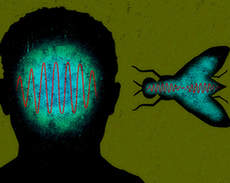
image source
We all have memories; some are jocular, some less so, some have emotional text. But did it ever transpire to you that we really don't know how we remember? Yes, i know, most of us knows that there is a particular area in the brain called the Hippo campus where memories abide. But that only tells us about the anatomical position of memories, not how they are formed. A recent unbelievable experiment, using our distant cousin ''the fruit fly'' ( This is a fly also known as Drosophila melanogaster it measures 3-4 mm in length and it's lightly brown in color) , took a first twinge at this problem.
Scientists have used light to program the memories of fruit flies. Contemplate about it: Light to program memories!. The research squad genetically engineered the fruit flies so that a small set of nerve cells in the brains would ''fire'' in reaction to a flash of laser light. This demonstrated which cells are involved in how a fruit fly learns and recalls what to avert, and offers an exciting new opportunity to investigate how memories are created.
''Remote-controlling these cells and and turning them on using light creates an delusion in the brain of the fly that it is undergoing something bad. The fly learns from the ''mistake'' it never really made and amends its actions the next time,''
By, Professor Gero Miesenbock
The Oxford scientists, with colleagues at the University of Virginia, Charlottesville, illustrated that they could use flashes of laser light to direct flies to dislike a certain odor.
They followed the flies using a video camera as they moved around a small cubicle while two different odors were fed into the chamber from either end. They discovered that they could insert a lasting preference for one odor over the other by remotely activating a specific set of brain cells each time a fly mislaid into a particular odor. Using this technique, the researchers were able to spot the precise cells that are responsible for telling the flies that they've done wrong, constricting down the search from the 100,000 cells in the brain of a fruit fly to a set of just 12 neurons.
This puts them in a location to follow this up and start to characterize the process by which memories are formed and arranged.
Amazingly, the source of this signals is in a confined number of cells- just twelve. These cells transmit signals that trains the fly to connect with something bad, so wherever their signals go must be the seat of memory. They can now follow this up and start to distinguished the process by which memories are created and organized.
While this work has been done in fruit flies, extensive lessons about how actions are learned and memories are stored should hold true for humans.
What is the relevance of fruit flies memory to our infinitely more complex brain?
.jpg)
image was culled from www.google.com
Biology teaches us that essential mechanism tend to be conserved. Knowledge about the storage of of memories from brain cells in flies should tell us a lot about how they are amassed in humans. Professor Miesenbock has pioneered this method of genetic engineering to remote control the action of specific cells within tissues, or whole organisms like worms, mice, and fruit flies, using light from outside. These attempts has given rise to a new field sometimes called ''optogenetics'', to point out that sensitivity to light is concealed genetically.
As the ability to write memories directly to the brains of fruit flies illustrates, optogenetic methods have particular power in neuroscience.
Why this?
Because we are no longer just docile observers of processes of brain. In the past, neurosciences had to be content with recording the twaddles of brain cells and trying to assume what it all meant. The ability to talk back and impact behavior directly is a game changer.
But do you get the fuzzily discomforting feeling as i do, that such methods in the wrong hands can be abused? After all, genetically engineering human beings is already in clinical litigation as a way to treat certain diseases. Once we master the technique, what would prevent a rouge scientist or a malevolent government from using it to direct thoughts and behavior by shining a laser light? At the dawn of the molecular biology era, anxious scientists saw the potential for mischief in the misuse of DNA genetic engineering. They summon in Asilomar, a conference site in the Northern California, and hammered out a code of scientific conduct that has served scientists and society enormously well. It is time for neurosciences to do the same.
Thanks for reading my article, if you like it please
Upvote
Resteem
Comment